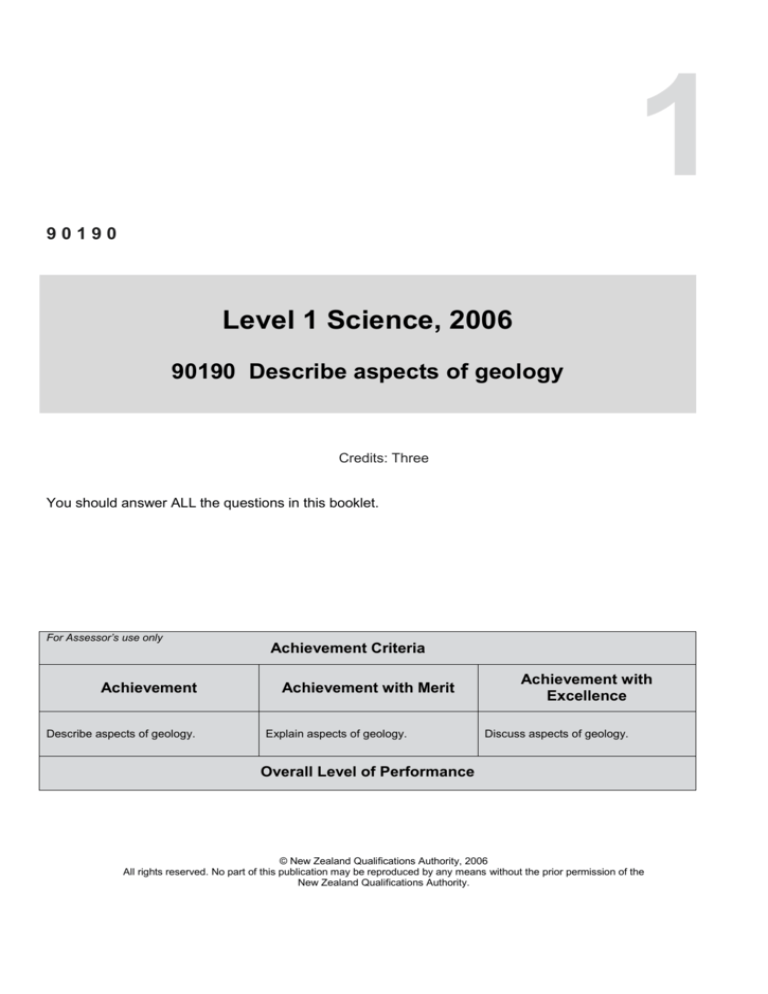
1
90190
Level 1 Science, 2006
90190 Describe aspects of geology
Credits: Three
You should answer ALL the questions in this booklet.
For Assessor’s use only
Achievement
Describe aspects of geology.
Achievement Criteria
Achievement with Merit
Explain aspects of geology.
Achievement with
Excellence
Discuss aspects of geology.
Overall Level of Performance
© New Zealand Qualifications Authority, 2006
All rights reserved. No part of this publication may be reproduced by any means without the prior permission of the
New Zealand Qualifications Authority.
You are advised to spend 25 minutes answering the questions in this booklet.
QUESTION ONE: GEOLOGICAL EVENTS
The diagram below illustrates a rock cliff exposure showing intrusive igneous rocks and a fault. Faults are
planes of weakness where rock is broken and displaced.
(a)
What major class of rock does sandstone belong to?
(b)
Explain what an igneous intrusion is.
(c)
State the order of the geological events that have occurred to produce the pattern of rocks shown in
the above diagram, and discuss how you were able to work out this order.
QUESTION TWO: FORMATION OF ROCKS
Metamorphic Rocks
(a)
Name TWO physical conditions involved in the formation of metamorphic rocks.
(b)
Name THREE examples of metamorphic rock.
(i)
(ii)
(iii)
(c)
Metamorphic rocks are formed by either contact or regional metamorphism. Compare and contrast
these TWO methods of formation. You should include ideas on scale, the physical conditions needed,
and give some examples of rocks formed by regional metamorphism.
L1 Science 2006, 90190 – page 2 of 4
Sedimentary Rocks
(d)
Name TWO examples of sedimentary rock, other than conglomerate.
(e)
Name a geological process that produces sediment.
(f)
Explain how a conglomerate is formed.
Igneous Rocks
Igneous rocks are often classified on the basis of grain or crystal size, what minerals they are made of and
whether the rock is dark or light or intermediate in colour.
(g)
Name an igneous rock that has very small crystal size and is poor (low) in silica content.
Granite is light in colour and gabbro is dark in colour.
(h)
Explain why these two rocks differ in colour.
The photographs below show examples of granite and basalt.
Granite
(i)
Basalt
Discuss the differences in the formation of granite and basalt.
L1 Science 2006, 90190 – page 3 of 4
QUESTION THREE: RELATIVE DATING
(a)
Describe what is meant by the geological term ‘stratigraphic column’.
The columns I to IV below represent rock layer sequences encountered in drill holes at four different
locations. Rock layers are the correct way up.
Using the rock layer letters A–E, determine the correct age order from oldest to youngest of the rock layer
sequences. Each different rock layer contains the kind of fossils as shown.
(b)
Write the letters of each rock layer in age order from oldest to youngest.
_____
Oldest
(c)
_____
____
_____
_____
______
Youngest
Explain your reasoning for the order of rock layers you have chosen in question 3(b).
L1 Science 2006, 90190 – page 4 of 4









